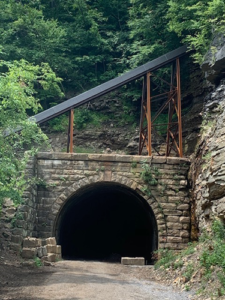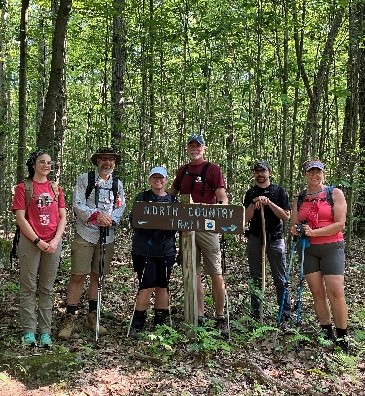
Sluice for stormwater management above the southern tunnel entrance.
Article originally published by PA DCNR
The Armstrong Trail follows the Allegheny River more than 35 miles from Rosston, Armstrong County north to Catfish, Clarion County. Much of the trail follows an abandoned rail corridor and features both historic and natural views. The trail also functions as a section of the planned 333-mile Erie to Pittsburgh Trail.
But the trail currently has a major gap in it: the Brady Tunnel. The century-old, half-mile-long railroad tunnel splits the Armstrong Trail’s southern and northern portions. Long abandoned, the tunnel is closed to the public for safety reasons.
Pennsylvania has identified the Brady Tunnel as one of the commonwealth’s Top 10 Trail Gaps. The designation means fixing the gap requires major infrastructure but could be completed within five years.
Armstrong Trails, Clarion County, and DCNR recently took a big step toward closing this gap. Through a pair of DCNR grants, Armstrong Trails reinforced the tunnel’s northern entrance. They also added a sluice above the southern entrance to channel stormwater away from the tunnel.
The work helped stabilize the tunnel and allowed Armstrong Trails and Clarion County to focus on fundraising to rehabilitate the entire tunnel. The goal is to someday welcome visitors to travel through this amazing piece of Pennsylvania history.
“The Brady Tunnel project is a collaboration of many, all who recognize the impact recreation has on the region,” said Chris Ziegler, executive director of Armstrong Trails. “Armstrong Trails is extremely excited to see the Brady Tunnel revitalized with a new purpose after sitting for decades untouched.”
Aside from tunnel repairs, the two grants added nearly five miles of length to the trail. They also funded engineering design work for rehabilitating the tunnel’s full length.
Total grant funding was more than $1.3 million, matched dollar-for-dollar. State funding came from the Keystone Recreation, Park and Conservation Fund.




